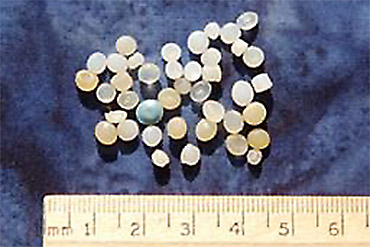 Research Areas > Marine Debris > Plastic Pellets on Beaches
Research Areas > Marine Debris > Plastic Pellets on Beaches
Project: Plastic Pellets on Beaches
Background and Objectives
Marine debris is often thought of as large items, found floating in the ocean or strewn along the beaches; however, smaller plastic items (<5mm), which are less noticeable, may present a larger problem to the health of marine organisms and the ecosystem on the whole. A study done in 1998 estimated a total of over 100 million plastic pellets on beaches in Orange County, California. Around one quadrillion of these pellets (60 billion pounds) are produced in the United States annually, and transported via railways, trucks and ships to manufacturers who then mold them into a final product. Some of these pellets are accidentally released during transport and find their way via stormwater drains and rivers to beaches and the ocean. Plastic pellets are a threat to marine organisms because of their small size (1-5mm) and ability to absorb persistent organic contaminants.
The California State Water Resources Control Board (SWRCB) and the Regional Water Quality Control Boards are required to implement a program to control the release of pre-production plastic pellets (PPP) from point and nonpoint sources. However, knowledge of the distribution and amount of plastic pellets on beaches in California is crucial to implementing a plan to control and reduce the discharges. In addition, a baseline study will be useful in determining the effectiveness of any programs or controls adopted by the State.
The goals of this project were twofold. First, it provided baseline information on the distribution and amount of plastic pellets on beaches throughout the State of California. The second goal was to conduct an intensified study in areas the pellets were found in from the baseline study to provide more detailed information on the distribution and amount of pellets in these areas.

Status
This project was initiated in 2009 and completed in 2013.
Methods
Researchers generated a stratified, random sampling design for sampling and quantifying plastic pellets along the entire coast of California. Sampling protocols were developed to ensure consistent collection and data recording. Sixty randomly selected sites throughout the state were sampled between June 29 and October 7, 2009. In addition, focused monitoring took place in coastal areas near likely distribution centers for plastic pellets, e.g., in the vicinity of the Los Angeles and San Gabriel Rivers. Focus locations were identified based on the number of plastics manufacturers, and again, a random sampling design was followed.
Findings
Researchers found widespread beach debris and PPP (approximately 210 million), with the greatest incidence in highly populated urban areas. The PPP distribution was mainly localized to four coastal counties: Los Angeles, Orange, San Diego, and San Francisco Bay Counties. Ninety-four percent of the PPP occurred in Southern California, possibly due to the large number of plastic manufacturing facilities in this region. Fifty-seven percent of the Los Angeles County coastline had PPP on its beaches, whereas Orange County had a 73% presence rate. The remaining coastal counties contributed only about 6% of the estimated PPP amount, and the northernmost counties beyond San Francisco showed an absence of PPP.
No significant difference in pellet abundance was found between wet and dry seasons. Sites proximal to river mouths had a higher abundance then those distal to river mouths, indicating that riverine runoff is a main transport mechanism for plastic pellets. The results suggest that focusing management efforts on riverine sources can greatly reduce plastic pellet abundance in the marine environment.
Partners
State Water Resources Control Board
California State University Fullerton

This page was last updated on: 4/18/2014